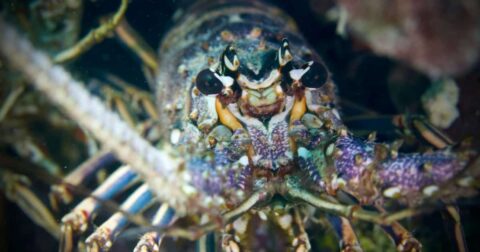Feature
How Much Meat Can You Eat and Still Be ‘Climate-Friendly?’
Research•9 min read
Explainer
The sentience of lobsters is being recognized by scientists — with ramifications for the culinary industry.


Words by Seth Millstein
Lobsters are considered a delicacy around the world, but the manner in which they’re killed is ghastly enough to make even the most seasoned seafood connoisseurs blanch. They’re slowly boiled alive, a process so unpleasant to witness that chefs will often leave the room while it’s happening. But are lobsters actually hurting when they’re boiled alive? In other words, can lobsters feel pain?
When tackling this question, it’s important to keep in mind that pain is a private experience, and its presence can only be definitively confirmed by the individual experiencing, or not experiencing, it. Because non-human animals can’t use human languages, we can never know with 100 percent certainty exactly how they’re feeling pain.
However, we can come to some conclusions based on the evidence we do have. Studies of lobsters’ behavior and biology, as well as existing knowledge of how pain works in general, strongly suggests that lobsters do in fact feel pain. And that’s important, given how lobsters are handled and treated by humans before being eaten.
“It is not possible to obtain absolute, objective proof of pain in any individual (humans or animals),” Francesca Conte and her collaborating researchers wrote in a 2021 paper about lobsters. “Yet it is commonly accepted that we should err on the side of caution in how we treat animals.”
Lobsters belong to the group of marine animals known as decapods, a type of crustacean that also includes shrimp and crabs. There are around 75 different species of lobster, and they’re generally divided into two categories: clawed lobsters and spiny lobsters. They’re found in every ocean, and both varieties are commonly killed and eaten by humans around the world.
Although they live underwater, lobsters can survive for several days out of water in the right conditions.
Lobster is served in restaurants around the world, but unlike many other animals that humans eat, they’re not commercially farmed. This is because of logistical difficulties stemming from their biology; lobsters are cannibals with ravenous appetites, and can take as long as seven years to reach “market” size. This makes it infeasible to farm them on a commercial scale, although some nascent efforts to do so anyway are underway.
The phenomenon of pain is closely linked to a type of neuron called a nociceptor. When the body is injured or exposed to potentially harmful stimuli, such as intense pressure or extreme temperatures, nociceptors communicate to the brain that the body is at risk, and should make immediate changes to their circumstances to avoid further injury. Nociception is, as the Association For The Study of Pain puts it, “the neural process of encoding noxious stimuli.”
In most cases, this “encoding” process results in a pain sensation, which prompts the person or animal in question to take action and avoid the noxious stimuli. But this isn’t always the case; it’s possible to have nociception without pain, and vice-versa. Nociception sometimes manifests as an involuntary reflex with no accompanying pain sensation. Likewise, certain types of pain, such as neuropathic pain common in stroke victims, occur without nociception.
Chefs generally kill lobsters in one of two ways: By slicing them in half, or by boiling them alive. These would undoubtedly be excruciatingly painful deaths for humans, but is either experience painful for lobsters?
Like humans and many other animals, lobsters do have nociceptors. This does not necessarily prove that they feel pain, but it does make it much more likely that they do, since nociceptors are the primary system through which pain is created in animals.
Research suggests that decapods in general are likely capable of feeling pain. A 2009 study of hermit crabs found that when exposed to an electrical shock inside their shell, they left the shell. That could potentially just be an unconscious reflex; however, a second study found that when exposed simultaneously to an electric shock and the odor of a predator, the crabs chose to stay in the shell. This implies that the crabs actively decided that the pain of the shock was worth enduring in exchange for avoiding the risk of a predator.
In addition, multiple studies have shown that when part of a decapod’s body is exposed to a noxious stimuli, such as a chemical or excessive pressure, they will rub and groom that area vigorously for an extended period of time afterwards. This behavior is widely recognized as an indicator of pain in animals, including humans, given that it persists even after the potential source of injury is gone.
From a strict observational standpoint, lobsters certainly behave as if they feel pain. As author David Foster Wallace wrote in his acclaimed 2003 essay “Consider The Lobster:”
If you’re tilting it from a container into the steaming kettle, the lobster will sometimes try to cling to the container’s sides or even to hook its claws over the kettle’s rim like a person trying to keep from going over the edge of a roof. And worse is when the lobster’s fully immersed. Even if you cover the kettle and turn away, you can usually hear the cover rattling and clanking as the lobster tries to push it off. Or the creature’s claws scraping the sides of the kettle as it thrashes around. The lobster, in other words, behaves very much as you or I would behave if we were plunged into boiling water (with the obvious exception of screaming). A blunter way to say this is that the lobster acts as if it’s in terrible pain, causing some cooks to leave the kitchen altogether and to take one of those little lightweight plastic oven timers with them into another room and wait until the whole process is over.
Or, put another, more succinct way: “Decapod crustaceans are capable not just of a reflex, nociceptive response, but of an actual experience of pain,” writes Dr. Maisie Tomlinson, co-director of Crustacean Compassion for the British Veterinary Association.
If lobsters do feel pain, the manner in which they’re treated prior to being eaten is extremely concerning. In addition to being boiled alive, they’re also put through the ringer during transportation after they’ve been caught; lobsters require very specific temperatures and moisture conditions in order to survive outside of their natural habitats, and they frequently arrive dead after shipping because those conditions haven’t been met. In order to minimize this risk, shippers will often starve lobsters for days before transportation, as this means that they will need less oxygen.
All of this begs the question of what, if any, welfare protections for lobsters have been put into law.
The answer is…some! Switzerland, Norway, New Zealand and the Italian city of Reggio Emilia, have all made it illegal to boil lobsters alive without stunning them first. In addition, storing live lobsters on ice in restaurants prior to their boiling has been banned in Switzerland and all of Italy, as both countries determined that doing so caused undue suffering to the crustaceans.
More recently, after years of tireless advocacy by animal rights activists, the United Kingdom passed a law in 2022 declaring that lobsters are sentient creatures capable of feeling pain. The law didn’t directly enact any additional legal protections for lobsters, but did establish the Animal Sentience Committee. This committee can issue a report on any decision made by government ministers related to animal welfare, and if the committee determines that the policy doesn’t properly consider the welfare of sentient animals, that minister is required to issue a written statement to Parliament in response.
These are undoubtedly positive and encouraging developments. However, the fact remains that in the overwhelming majority of the world, lobsters don’t have any legal protections, either in culinary or research contexts. This is why animal welfare campaigners continue to push for more measures to protect lobsters from undue suffering.
One such measure is the CrustaStun (short for “Crustacean Stunner”), a device created in 2006 as a less inhumane alternative to boiling lobsters alive. Chefs place the lobster inside the CrustaStun, and it delivers a shock to the lobster that anesthetizes it immediately and kills it within seconds.
Although CrustaStun, at $3,400, is still a bit pricey for consumers, industrial models are now in use in the UK, Norway, Portugal and Ireland. Two UK retailers, Tesco and Waitrose, only sell lobsters who’ve been killed via stunning, according to the welfare group Crustacean Compassion, and several world-renowned chefs have begun using the device as well. There are some other small signs that the seafood industry is finally starting to take the welfare of lobsters and other crustaceans more seriously. A 2022 survey of seafood processors and retailers issued by Crustacean Compassion and Chronos Sustainability found that half of the companies in question had policies on the books to promote decapod welfare — although unfortunately, only two-thirds of them had enforcement mechanisms to ensure those policies were followed.
The question of whether people are willing to examine the potential pain a lobster experiences when being fished, caught, transported and slaughtered formed the conclusion of Wallace’s iconic 2004 essay. Nearly two decades later, the populations of several countries around the world are starting to take note of the emotional experiences of lobsters, crayfish, crabs, prawns and shrimp — even as they continue to kill and eat them.